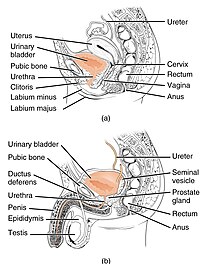
Photo from wikipedia
ABSTRACT A quick, well-timed pelvic-floor muscle contraction during physical effort is recommended for active women to prevent urine leakage. Purpose: We address two research questions: how well do future female… Click to show full abstract
ABSTRACT A quick, well-timed pelvic-floor muscle contraction during physical effort is recommended for active women to prevent urine leakage. Purpose: We address two research questions: how well do future female exercise professionals contract the pelvic-floor muscles, and whether the biofeedback session is necessary to train them to contract pelvic-floor muscles? Method: Participants were 84 nulliparous future exercise professionals (age 23 ± 3 years, mean ± SD), randomly allocated into biofeedback (n = 27), usual-advice (n = 26), and control (no advice, n = 21) groups. Contraction of pelvic-floor muscles on a 4-point scale (1 = incorrect through 4 = correct) was assessed in all groups by surface electromyography (sEMG) with a vaginal probe before and after 6 weeks of intervention. Results: In pretest, almost one in five participants (17%) could not activate the pelvic floor and less than half of them (45%) presented correct technique. The technique score for the three groups was 3.1 ± 1.1 (mean ± SD). After training, both intervention groups presented better technique score by 0.6 (90% confidence limits ± 0.5) relative to the control group, and two-thirds (65%) of the intervention groups presented the correct technique. Conclusions: Future exercise professionals displayed poor skills in contracting pelvic-floor muscles. Both training interventions (with and without biofeedback) were effective for this study group.
Journal Title: Research Quarterly for Exercise and Sport
Year Published: 2019
Link to full text (if available)
Share on Social Media: Sign Up to like & get
recommendations!